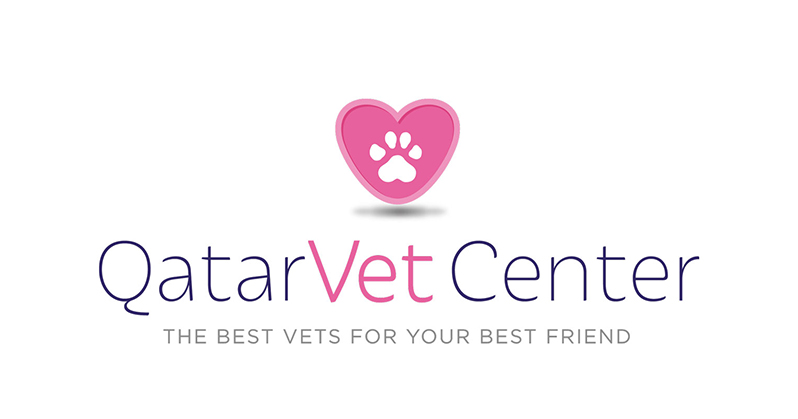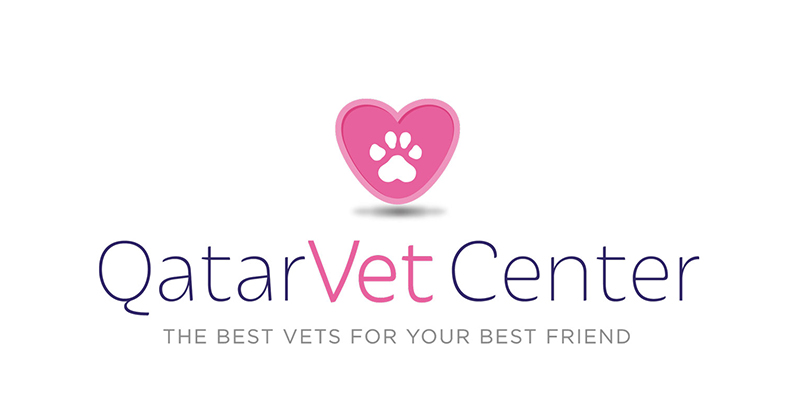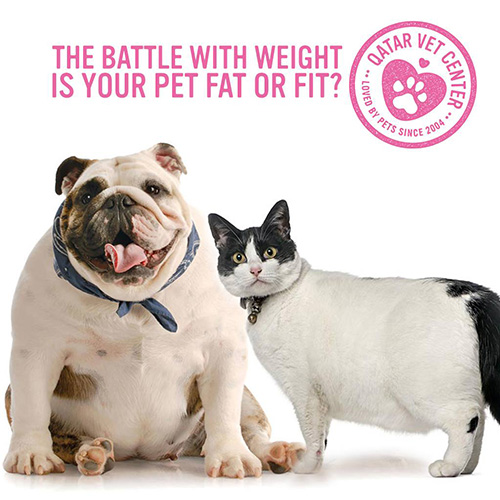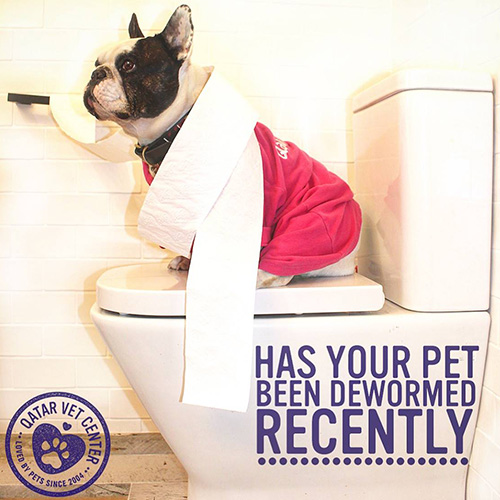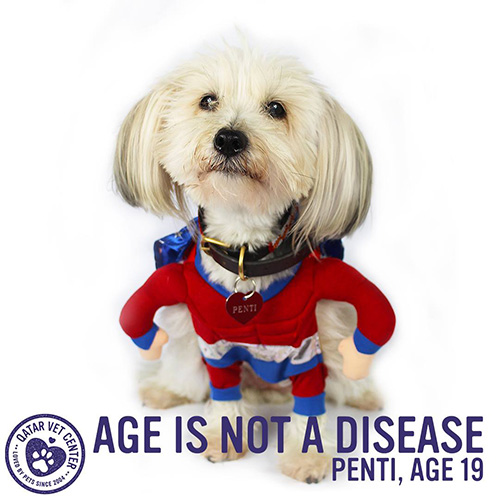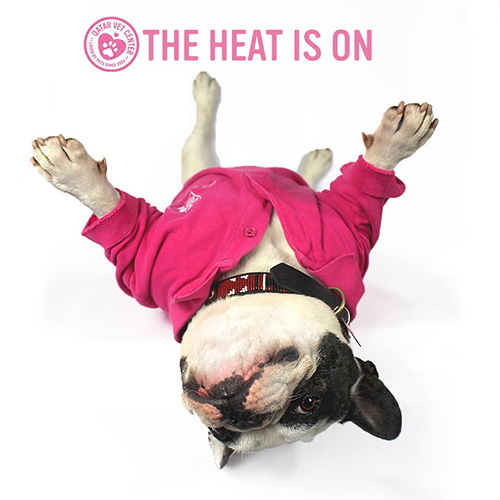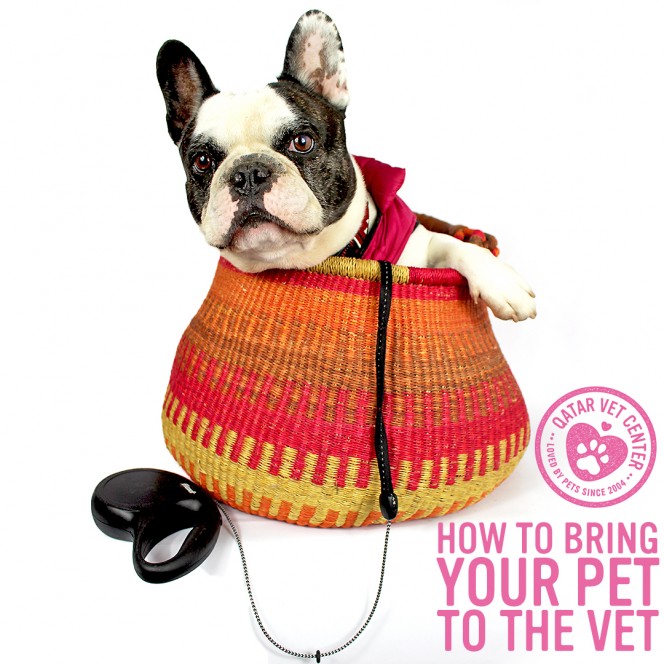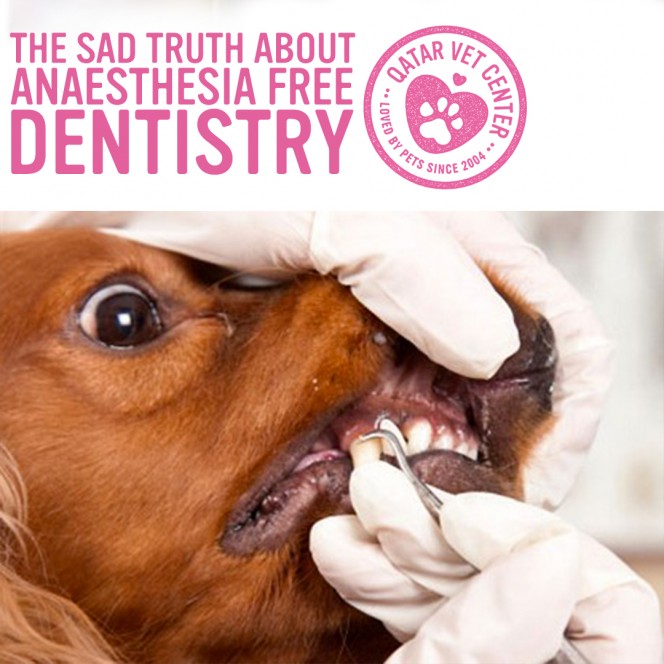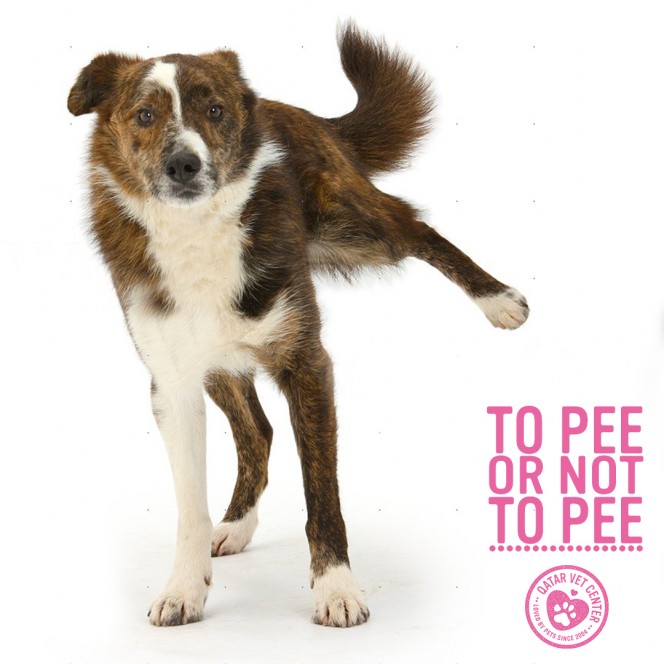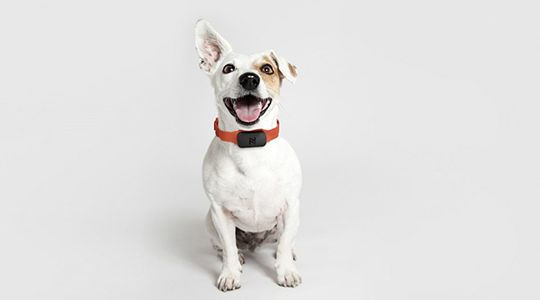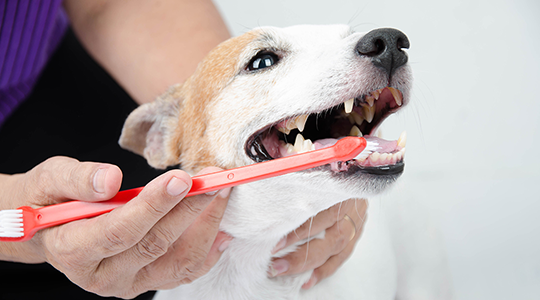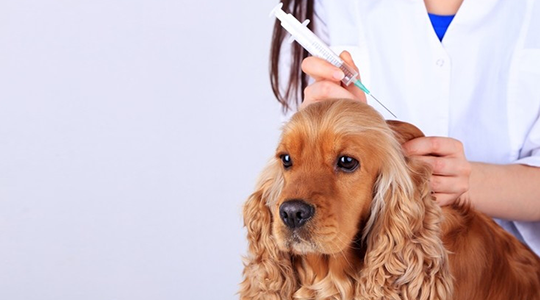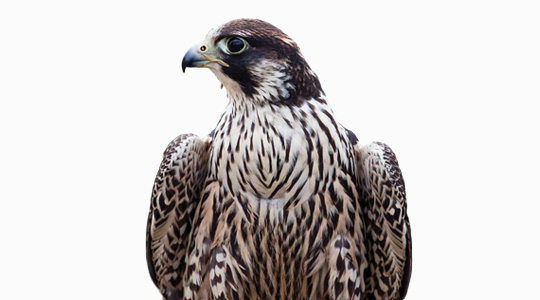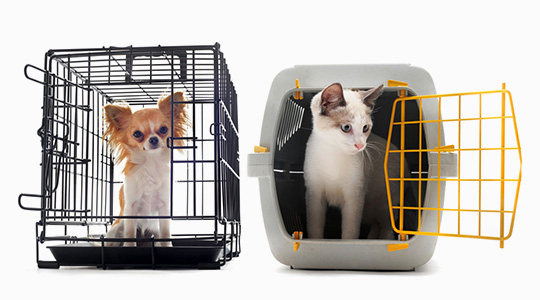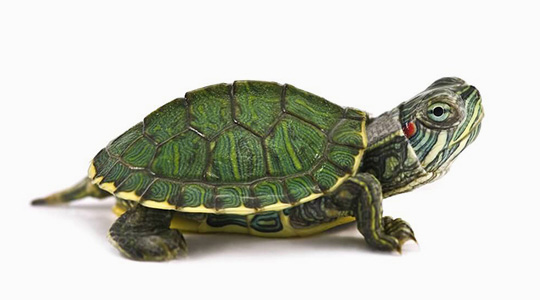Your pets’ teeth. It’s a super important topic. Proper dental care is becoming more and more common for dogs and cats. Pets often hide their dental pain well. Some signs you might see at home that could mean a potential problem include drooling, bad breath, dropping food, and eating less. Many pets show nothing and suffer in silence.
The first place to start is with a thorough dental exam by your Qatar Veterinary Center Veterinarian. This can be done as part of the yearly visit, or any time if you have a concern. This exam includes a look at the lips, gums, and teeth. The veterinarian is looking for signs of tartar, inflamed or red gums, infection, extra and broken teeth. Based on this examination, the doctor may then recommend to have a more complete oral assessment done under anaesthesia. At this time the teeth would also be cleaned ultrasonically and polished. Extraction of infected or broken teeth would be done. A dental cleaning should always be done under gas anaesthesia with intubation, meaning there is a tube in the trachea (the windpipe) to protect the pet’s lungs from water.
There are also plenty of things an owner can do at home to promote a healthy mouth for their cat or dog. These are most effective when started young, or after a professional cleaning has been done by your vet. Brushing often (multiple times a week) with a pet friendly toothpaste is excellent. There are also dental wipes, treats, water additives, and foods. We offer Royal Canin “Dental” diet at QVC. All of these things can help prolong the time between dental cleanings at the vet and help prevent future extractions. If you have questions or concerns about your pet’s teeth, make sure to call Qatar Veterinary Center for an appointment to assess the mouth and talk about the next step!
Dr. Sam DVM
and Bandido, QVC Spokeswoof
Just like many of their owners, pets all over the world are facing the battle of the bulge, that is, weight gain. At Qatar Veterinary Center we see overweight cats and dogs on a daily basis. Some are just mildly so, others are already obese. Although owners often associate giving extra food and treats to their pets with love, these extra pounds can unfortunately be really harmful to their health. The extra weight can be hard on their heart, joints, and metabolism. A study has even found that overweight dogs live an average of two full years LESS than their normal weighted siblings. There are two factors to weight gain and weight loss, that is diet and exercise. Regular exercise is very important to your pet’s mental and physical health. Pets who are out of shape need to start slowly, this can be short sessions of playing with toys for a cat, or short walks or swims for a dog. With the hot weather approaching here in Qatar we must use extreme caution with outdoor exercise. The most important factor is diet. Some pets just need to eat less, others may need a light food or a prescription diet, some may need blood testing to rule out a medical problem. If you are unsure if your pet’s weight is normal, or are having trouble controlling their weight, please make an appointment to see your QVC Veterinarian for an exam and to make a plan to help keep your pet healthy.
Dr Sam, DVM
All sorts of parasites inhabit animals and people throughout the world. When you bring your dog or cat into Qatar Veterinary Center, whether it be for vaccinations or illness, you may hear us ask, “Has your pet been recently dewormed?” This is an important question. Some of the most common worms found in our beloved pets can cause them harm, or even be passed on to people.
Hookworms are common here in Qatar. Adult hookworms can live in the intestines of dogs and cats and suck their blood. Eggs are spread through the pet’s feces. They can cause serious blood loss to your pet, which can even be life threatening especially in smaller breeds or puppies. Hookworms can infect humans either by the fecal/oral route (ex. a child touches the feces then touches their mouth) or by going through our skin (ex. walking barefoot on a beach where dogs have been going to the bathroom). This can make us ill or get an itchy rash. Hookworms are almost never seen by an owner. Roundworms are also common in our pets. They too pass eggs in the feces but do not get through our skin. Roundworms can make our pets feel weak, have a poor coat, and lead to vomiting or diarrhea. Although they live in the intestines of dogs and cats, when they get in a human they often get confused and wander to other places. They can end up in other areas such as our lungs, heart, and even our eyes, causing blindness. Roundworms too are almost never seen by the owner. Our other most common parasitic worm is the Tapeworm. This one infects our pets when they eat things like fleas, rodents, and organ meat. They can make our pets lose weight and just feel generally unwell. This worm is often identified by the owner when they see tiny rice-like segments near the pets rectum or on the stool. It is rare for this worm to pass from a dog or cat to it’s owner.
Trying to keep our pets parasite free is really important for both their health and ours. Even more so with children in the home. At Qatar Vet Center we recommend deworming your cat or dog every 3 months. This is a simple and easy procedure that can be done at home. If you have any questions regarding parasites please contact your QVC veterinarian.
Dr Sam, DVM
Our senior dogs and cats (sometimes called “geriatric”) often need more care and veterinary attention than do younger ones. These are usually considered pets over 7 years of age, but that can vary a lot by breed and size as well. Dogs and cats age much faster than their owners. As our pets age, much like us, they can start to have aches and pains, signs of early disease, or even mental changes. When bringing an older pet to the vet, giving a detailed history of their life, activities, and appetite at home can be just as important as the physical exam. Doing regular weight checks on an older pet can also provide a lot of information. Although traditionally most people bring their pet to the vet once yearly unless they are sick, as a pet reaches older senior status, it can be beneficial to come in every 4-6 months to talk with the doctor and have the animal examined. It can also be very helpful to your pet’s health to have yearly blood work checks done on senior pets even if they are not yet showing signs of being sick. In these checks the vet is looking for signs of anemia, kidney disease, diabetes, liver disease, thyroid hormone issues, and more. Older animals may need to eat a different diet, take supplements or medications, or have adjustments made at home to make life easier. If you have a senior pet that needs a check up, we encourage you to book an appointment with your Qatar Veterinary Center Veterinarian. We’d be happy to help!
Dr Sam, DVM
Spokes woof: Penti, age 19, QVC Rescue
With the mercury rising every day here in Qatar we know how very hot it is, but sometimes we forget about how sensitive our pets can be to the heat. Dogs, cats, birds, and many exotic pets like rodents and rabbits can all suffer the effects of getting too hot. An animal can first suffer from heat stress before it has a full blown heat stroke. It is important during the hot summer months that we shorten the amount of time our pets spend outside. This includes walks, playing, and going to the bathroom.
We must never leave a pet in the car with the engine off even for a moment.
The pavement can also get to be blazing hot and this can easily burn the pads of the feet on even a short walk.
Very young and very old animals are at higher risk for heat stress as they have more trouble regulating their own temperature. It is important even inside the home to always have a few bowls of fresh cool water available to our pets all the time. Animals that spend a lot of time in a separate room or building from the home should still have air conditioning, open windows are not enough.
Signs that your pet is too hot may include excessive panting – even to the point of drooling, a fast heart rate, red gums, and collapse. If you think your pet is suffering from overheating it is important to call Qatar Veterinary Center reception immediately and then come in, as this is a life and death emergency.
Just a few minutes left outside can be too long.
Dr. Sam, DVM
& Bandido, QVC Spokeswoof
Hi! We saw you have been using Counter Number showcase plugin for a few days and wanted to ask for your help to make the plugin better.We just need a minute of your time to rate the plugin. Thank you!
At Qatar Veterinary Center we understand that getting your pet into the clinic can be a stressful event. There are some really important tips to keep both the animals and the clients safe while here at the hospital. All dogs must be on a leash or in a carrier. The leash must be of normal length ( 2 meters) in order to maintain good and easy control. Retractable leashes are not a great choice for Vet visits and can cause injury to both the pet and the owner while providing very little control. Although your dog may be very friendly and listen perfectly when off leash, there may be other dogs here in the waiting room, who do not. All cat patients must be in a carrier. Cats who are carried in loose in the owners arms may suddenly become afraid or upset and can easily run away from the owner at a moments notice. This can also happen in the parking lot. It is important to keep your cat in the carrier with the door closed until you reach the exam room. The carrier should have a towel or pee pad in the bottom and may have something familiar to the pet like a toy or bed. It is not necessary to provide litter inside the cage, as this often becomes messy. Most pets do not require food or water for their short trip to the Vet, this often gets spilled and causes the pet to get wet. Birds should be in a travel cage, this is generally smaller than the cage that they may live in at home and does not contain toys and other obstacles, making it easier for the Veterinarian to capture and handle the bird safely. Small exotics such as rabbits and hamsters should also be in a smaller travel cage. Following these tips can help to make your visit to QVC a safe and positive one.
Dr. Sam, DVM
Dentistry and Anesthesia
Here in Qatar, like in other countries around the world, we are starting to see a rise in the “anesthesia-free dental”. This is a procedure that is often offered by groomers and pet stores where they attempt to clean your pet’s teeth while fully awake. This is not the same as tooth brushing. These businesses often play on a pet owners fear of anesthesia in order to promote this procedure. The problem is, that doing a proper full dental exam, ultrasonic cleaning, and polishing on a dog or cat who is awake is impossible. Without anesthesia this procedure is dangerous in that it is not thorough and all dental problems are often completely ignored. While it may make the areas of the teeth that are visible to the owner look whiter and brighter, this is just cosmetic and does not help your pet. The tongue side of the teeth will not be properly cleaned, under the gum line (the most important area) will not be properly cleaned, and each tooth will not be examined by a veterinarian in order to look for dental disease. No extractions, if needed, will be performed. Owners are often fooled into thinking that everything is going well with their pet’s teeth after they have paid to have this done, when in fact they may be suffering daily in silence from infection and chronic pain coming from the roots of the teeth.
A proper dental evaluation and cleaning must be done under anesthesia by a licensed veterinarian. Your QVC vet can evaluate your pet’s health with a good history, full body exam, and possibly blood work prior to a dental. Then they can decide on a balanced anesthesia plan that is best and safest for your cat or dog. Please do not be fooled, “anesthesia-free dentals” are dangerous to your pet’s oral health and are never appropriate.
Dr Sam, DVM
Sweet but Deadly
Many pet owners are aware that certain foods, like chocolate, are not safe for dogs. One product not everyone is familiar with is Xylitol. Xylitol is an artificial sweetener that is put in many of our low calorie foods. We love it because it makes things taste great but does not add extra calories. Dogs tend to love it too. Xylitol is often found in sugar free gum, toothpaste, peanut butter, Jello, candy, drink mixes, and protein bars. Check your ingredient lists. Different products as well as different flavors of the same product can all contain varying amounts of this sweet ingredient. When fed to your dog on purpose or by accident, xylitol can be extremely dangerous. A single stick of gum could have very serious consequences to a small dog. It seems that cats are not affected.
When a dog eats xylitol, it’s body mistakenly thinks it ate sugar and releases a large amount of the hormone insulin. Since the pet has not eaten any real sugar at all, this can cause dangerously low blood sugar levels, which can lead to vomiting, weakness, and seizures. These symptoms can show up as quickly as thirty minutes after eating the item, or hours later. Some dogs will develop serious liver disease eight to twelve hours after, which often leads to death.
If you know or think that your dog has eaten something containing xylitol it is important to call your Qatar Veterinary Center Veterinarian right away. Never wait until the symptoms appear. The veterinarian may want to purposely make your dog vomit, check the blood sugar, and likely start an IV drip containing sugar. Remember that prevention is key! It is important to always keep all foods containing xylitol, including gum, well out of reach from your furry friends.
Dr. Sam, DVM
with Bandido, QVC Spokeswoof
 Pee Pee ProblemsAt Qatar Veterinary Center we see plenty of appointments that are marked as “trouble with urination”. These issues can come up for both cats and dogs, and can include a wide variety of problems.
Pee Pee ProblemsAt Qatar Veterinary Center we see plenty of appointments that are marked as “trouble with urination”. These issues can come up for both cats and dogs, and can include a wide variety of problems.Sometimes it can be behavioral. In dogs this can include troubles with potty training puppies or older adults who are newly adopted. In cats it might be arguments between cats, marking of territory, not enough litter boxes, or the wrong type of litter.Urinary problems could instead be a medical issue. Dogs often get bladder infections, crystals in their urine, or even bladder stones. Sometimes dogs, especially spayed females, can have urinary incontinence, where they leak urine when they are relaxed. Cats tend not to get infections, but instead get blood in their pee. Male cats are also well known to have urinary blockages, where they try but can not pee at all, and that’s a life and death situation.Many urinary issues are painful to your pet, and some are really dangerous their health. They are also often stressful to the pet owner. If you see signs that your pet is having issues with peeing such as urinating in strange places, urinating small amounts, urinating with blood, or straining to urinate, it is important to make an appointment with your Qatar Veterinary Center Veterinarian. If your pet is unable to pass any urine at all then it must be seen as an immediate emergency! Your pets urinary health is always our concern.
Dr. Sam, DVM
WHY SPAYING OR NEUTER YOUR SPECIAL PET
Medical Benefits
Spaying and neutering, in addition to controlling the pet population, has many medical benefits:
- The average lifespan of a spayed or neutered pet is 40% longer than an unaltered one
- Un-spayed females may develop breast cancer or uterine infections by 8-10 years of age
- Spaying a female before first heat almost eliminates her chance of developing breast cancer
Problems for Owners of Intact Pets Problems associated with intact pets
1) Un-spayed female cats are in heat frequently, which is noisy and troublesome.
2) Un-spayed female dogs experience messy heat cycles two to three times a year.
3) Un-neutered male cats tend to mark their territory by spraying urine.
4) Un-neutered male dogs are at risk of testicular tumors, prostate disease, & peri-anal tumors.
5) Intact pets tend to be territorial and wander, leading to automobile injuries, fight wounds, and exposure to contagious disease. Neutering can help control or eliminate associated behavioral problems such as aggressiveness, urinating in the house, and running away from home.
The Solution:
Spay or Neuter
Spaying or neutering your pet is a safe, routine procedure, generally performed at 6 months of age. Prior to surgery, all pets will receive a pre-anesthetic physical exam. We strongly recommend pre surgical blood screening, which helps us detect many potential problems and increases anesthetic safety for your pet. For dogs over 10kg, laparoscopic or keyhole surgery at our Duhail branch is an option.
We also strongly recommend postoperative pain medication, ensuring a comfortable, speedy recovery for your pet. The surgical procedure is performed under general anesthesia, so your pet sleeps painlessly throughout.
When Your Pet Has Surgery
These surgical procedures can be scheduled Sunday – Saturday. Here are some points to remember:
- Please call 24 hours in advance to make your appointment.
- Plan to drop your pet off at the hospital between 8.00 and 9:00 AM .
- Withhold food and water for 8 hours prior to surgery.
We strongly recommend that pets go home with pain medications to be given for several days following surgery and some may also receive antibiotics. The doctor will make these decisions and advise you upon discharge.
REMEMBER: Spaying or neutering your pet will help it to lead a healthier, happier, longer life and you will have done your part to reduce the pet overpopulation problem!
Just like humans, pets’ teeth need looking after too!
Over 85% of all dogs and cats over 3 years of age will have some sign of dental disease. This is inflammation or infection of the tissues that surround and support the teeth.
The health of your pets teeth and gum’s has a significant impact on their overall quality of life
Imagine how your mouth would feel, and smell, if you never brushed your teeth. Imagine having a really bad toothache and not being able to tell anyone about it!
Dental disease begins with a build up of bacteria in your pet’s mouth. Bacteria, combined with saliva and food debris, can cause plaque to accumulate on the tooth. As calcium salts are deposited, plaque turns to tartar (brown or yellow material starting near the gum line of the tooth).
Without proper preventive or therapeutic care, plaque and tartar build-up leads to periodontal disease, which affects the tissues and structures supporting the teeth. Periodontal disease can cause oral pain, tooth loss and even heart or kidney problems. Common signs of dental disease, in order of severity, include:
- Yellow-brown tartar around the gum-line.
- Inflamed, red gums
- Bad breath
- Change in eating or chewing habits (especially in cats)
- Pawing at the face or mouth
- Excessive drooling
- Pain or bleeding when you touch the gums or mouth
If your pet is showing any of these signs of dental disease please book an appointment to see one of our veterinarians. Early assessment and action can save your pets teeth!
How can I prevent dental disease?
Long term control and prevention of dental disease requires regular home care. The best way to begin this is to accustom your pet from an early age. Dental home care may include:-
- Brushing teeth daily – just like us. This is the best form of dental hygiene. Pet toothbrushes and toothpaste are now available. Please do not use human toothpaste formulas on your pet as they are not designed to be swallowed and may be toxic.
- Feed special dental diets. This can help reduce the accumulation of tartar.
- Use dental toys, enzymatic chews, or teeth cleaning biscuits, all of which may help keep the teeth clean.
Regular and frequent attention to your pets teeth may avoid the need for a professional dental clean under anesthetic and will also improve your pets overall health.
What does a professional dental clean involve?
It is the same as a scale and polish done by a dentist for us. However, unlike us, our pets won’t sit still or open their mouth to allow a comprehensive cleaning of their teeth. For this reason our pets need to have a general anesthetic for a professional dental clean .
Your pet will need to be assessed by one of our veterinarians. The degree of dental disease will be assessed to determine if extractions, antibiotics and anti-inflammatory will be required.
The assessment may also include a physical exam, blood tests and urine tests to ensure they are healthy prior to having an anesthetic. Once anesthetized, we can give the teeth a thorough cleaning using our specialized dental equipment. When your pet goes home we will also discuss methods of reducing dental disease in the future.
If you have any questions about dental care or professional cleaning please do not hesitate to contact us.
Vaccinating from as early an age as possible and maintaining protection throughout the life of your pet is the best way to avoid preventable and often deadly diseases.
Additionally, keeping your pets vaccination status up to date is essential if you are to be prepared for travel.
When to vaccinate
When puppies and kittens are born they are usually protected from infections by their mother’s milk, providing she has been regularly vaccinated. However, this protection only lasts a few weeks so they need regular vaccinations from an early age.
Puppies are typically vaccinated at eight, twelve and sixteen weeks, kittens at eight and 12 weeks, with an initial course of two injections. Your young pet should then be given a booster every 12 months after their first vaccination.
Dont stop as your pets get older, senior pets need protecting too, as their immunity can decline.
Vaccines against infectious diseases
Dogs
Dogs should be routinely vaccinated against:
- Canine parvovirus
- Canine distemper virus
- Leptospirosis
- Infectious canine hepatitis.
- Parainfluenza
If your dog will be spending some time in kennels they may also be given a kennel cough vaccine. This vaccine is usually given intra-nasally (into a nostril) and protects against bordetella bronchiseptica.
All Dogs and Cats require a rabies vaccination. The first rabies vaccination is usually administered at 12 weeks of age and thereafter annually
Cats
Cats should be routinely vaccinated against:
- Feline infectious enteritis
- Feline herpes virus
- Feline calicivirus and, where appropriate Feline leukaemia virus
The sport of falconry began over 5,000 years ago in Iran, and spread over the centuries to East and West. The sport was introduced to Qatar through Bedouin tribes who used the birds as a tool for hunting. They discovered that it was much easier to allow the raptors to take down birds migrating across the Arabian Peninsula than it was to shoot them down themselves. This Bedouin method of falconry set the basis for the modern version of the sport practiced in Qatar.
Although, over the centuries, falconry has virtually disappeared from the European continent, the sport lives on in the Middle East. In Qatar, you can still purchase falcons in downtown Doha at falcon souqs or through private dealers. The best raptors can cost thousands of dollars and may even be issued their own Qatari passports to ensue they are not stolen or taken out of the country without the owner’s permission. Due to these elaborate methods of theft prevention, it is not uncommon for you to be seated beside a full-grown falcon when travelling on a Middle Eastern airliner.
Once you have purchased (or caught and trained) your falcon, you proceed to enter a very competitive sport. Many Qataris spend fortunes on their falconry equipment, which can include radio monitors, 4×4 trucks, communication devices, and other high priced items. The reason for the high-tech equipment is so that the hunters can arrive right when the bird is taking down its prey, so they may separate the animals and kill the prey according to Islamic customs.
But if you are considering participating in this ancient sport, remember that a large amount of time must be invested in training the birds, especially if they are caught in the wild. One of the techniques involves keeping the bird on one’s arm for several hours a day, which, aside from being painful, would obviously prove problematic to anyone who has a regular job.
The most popular prey is the Houbara bustard, a large, fast bird, which lives throughout the Middle East. That being said, the bird has been hunted to the point of being endangered in Qatar. So falconers must constantly travel the globe to search for new hunting grounds. It is said that the best hunting grounds are found in the Iraqi desert.
Falconry offers a glimpse at how Qatar used to be. The millennia-old sport remains extremely popular amongst Qatar’s elite and new efforts to restock the Qatari desert with Houbara bustards will ensure the sport continues.
We know how important your pets are to you, which is why we strive to extend our 5-star service to your furry and feathered friends when they travel. Harmless, domesticated dogs, cats, and birds can travel as excess baggage on the same flight. For details and charges, you may refer to the FAQs below or contact your local Qatar Airways office.
Please note that the transportation of animals is subject to local country regulations. Please ensure you allow sufficient time to check with the local authorities of your departing and arriving countries for their respective regulations and procedures for transporting animals. It is the customer’s responsibility to ensure all necessary documentation is available before travel.
Even people who don’t like reptiles often are attracted to turtles and tortoises. They’re cute and appealing. And they seem like the kind of simple pet that you keep in a nice tank, toss food at once in a while and that’s it.
Even Lisa Chicarella thought that way at one point. “I was under the impression they were like goldfish in shells,” she says.
Now Chicarella knows there’s a lot you can get out of owning a tortoise: Her African spur-thigh tortoise, Wasabi, is a therapy animal with Pets on Wheels in Maryland. But she also knows how much work it takes to live with one.
After Chicarella’s dog, Chief, died, she talked to the director of the therapy organization. “I said I didn’t have a therapy animal anymore; too bad Wasabi couldn’t be one. She said, ‘Why not?’”
Wasabi turned out to be a big success. She’s famous for wearing a dress, which is a great icebreaker, but it started out for practical reasons. Lesson No. 1 in reptile keeping is that these animals don’t produce their own body heat: Wasabi needs to wear thermal wraps to keep her warm when she works in the winter. The dress conceals them, but it was such a hit that now she wears it all the time.
Difficult to Contain
The tortoise got her name because “she’s hot stuff,” Chicarella says. “When I first got her, she literally wouldn’t come out of her shell for two weeks. But once she popped out, she never went back in.”
However, while owning a dress-wearing therapy tortoise can be pretty cool, it comes at a price.
Says Chicarella, “My entire existence revolves around Wasabi.”
Wasabi’s species is common in the pet trade, but buyers rarely realize what they’re in for. “When you get them, they’re tiny — about the size of an egg,” Chicarella says. She got Wasabi as an adolescent weighing about 12 pounds, and now, seven years later, she tips the scales at more than 40 pounds and is very active and strong — with little respect for human property.
“For a tortoise Wasabi’s size, drywall is simply a suggestion,” Chicarella says. One of her pet’s favorite pastimes is moving the furniture around. “She’s always into something,” she says. “She’ll push the ottoman around all day.” Wasabi has broken several kitchen chairs, which Chicarella sometimes discovers by sitting on them.
And that’s only the start: Wasabi will keep growing till she’s about 100 pounds. But, Chicarella says, “to keep her locked up wouldn’t be fair” because she’s so active and, yes, intelligent. “She’s very much a thinking little being. I can see her trying to figure out things. I tell her ‘No,’ and she hisses at me.”
Along with Wasabi’s challenging day-to-day management, Chicarella has to plan for the long term. Wasabi is expected to live 50 to 75 years, so she’s provided for in Chicarella’s will.
Buyer Beware
A big problem with turtles and tortoises is that the most common species in the pet trade are not necessarily the most suitable pets. Chicarella says that while for her, Wasabi is worth it, she recommends that no one get an African spur-thigh. “For the record, they’re terrible, terrible pets,” she says. “I enjoy her, but it’s an amazing amount of work. They’re not for the faint of heart.”
The most common semiaquatic turtle, the popular red-eared slider, also presents a case in which buyers generally don’t know what they’re getting into. While it has been illegal for some time to sell a slider that’s less than 4 inches long, the law is not well-enforced, and buyers aren’t told that when that little turtle grows up it will be big enough to need a 75-gallon aquarium.
Because turtles are messy eaters and produce a lot of waste, their tanks need more filtration than would be needed for a fish tank of the same size. And no matter how often you see them kept in purely aquatic environments, such setups are not ideal. An aquarium — if you use one — needs to be set up specifically to meet the turtle’s needs. “They’re not fish,” says Barbara Daddario of the New York Turtle and Tortoise Society. “Most still need a place to haul out and get completely dry.”
So if you’re interested in a turtle or tortoise, it’s critical to do your research — both about individual species and about the reptiles in general.
